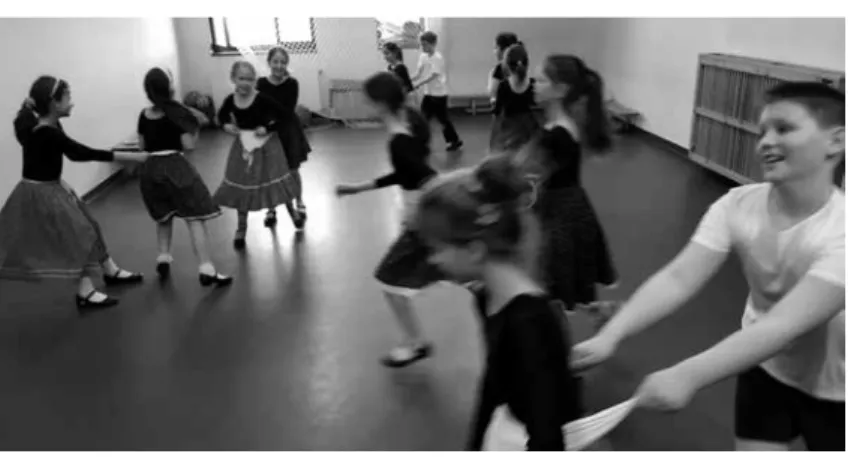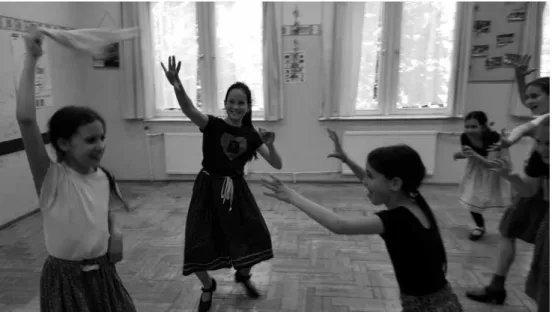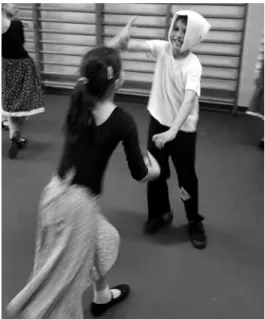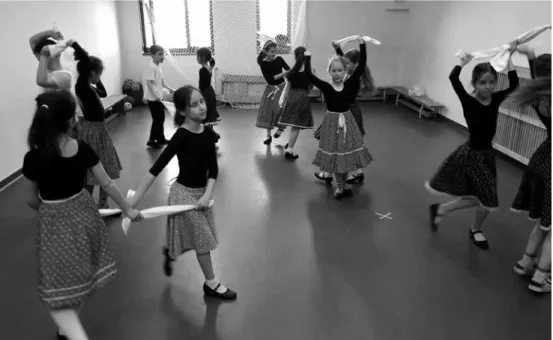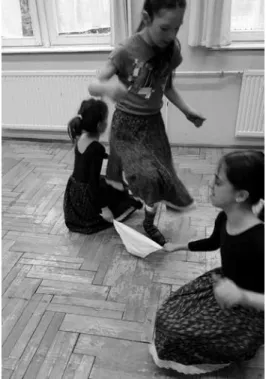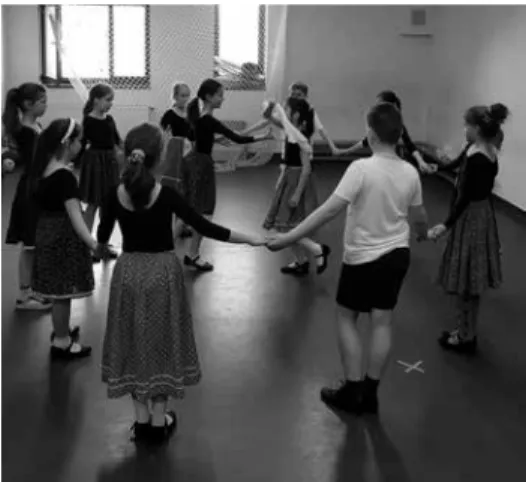Tánc és Nevelés. Dance and Education, 2(2), 75–86., DOI: https://doi.org/10.46819/TN.2.2.75-86
CHILDRENS’ SCARF DANCES.
ABOUT FOLK DANCE BEYOND MOTIFS
Anna Gordos, folk dance and folklore teacher Abstract
The scarf is a less used tool in the methodology of teaching folk dances. This object, however, had a crucial role both in Hungarian folk dance tradition and in the way of life of peasants. The paper presents the traditional appearances of the scarf in dances and its usage’s symbolic semantic layers with a special focus on wedding pair-choosing dances. The scarf has a privileged role in these playful pair-swapping games, on the one hand as the realisation of improvisation, on the other hand as a means of creating an equal relationship between dance partners. These structural and conceptual conclusions could be translated and applied in the process of dance teaching: the scarf as a tool of methodology eases communication, reveals the dynamism between dance partners and the emotional aspects of dance. The present study is followed by a supplement of 12 scarf games, which provides new ideas for practising dance teachers on how to use the scarf in teaching folk dances.
Keywords: scarf, folk dance, methodology
In my degree thesis at the Hungarian Dance University,1 I started to deal with the fact how neglected the scarf is, a tool able to provide a lot of options for development, side by side with other generally applied2 tools such as the stick, the skipping rope, the bean bag, the hoop (Pusztáné Gordos, 2019). The use of scarves was widespread in peasant culture: they served as an everyday object, a ritual tool, a toy for games and dances. In the following paper, the original usage in games and dances will be discussed, paying attention to present-day pedagogical aspects as well.
1 I had the opportunity to present the advantages of scarfs in dance-gamies development and its background in folkloristics at a conference as well (Gordos, 2020).
2 This is primarily thanks to Péter Lévai’s ideas in folk dance methodology which have influenced a great many folk dance teachers when beginning with learning dances based on imitation, going on in the direction of creating one’s own dances. (Lévai 2015, 2019; Pignitzkyné Lugos & Lévai, 2014).
AnnA Gordos
1. SCARFS IN DANCE
A scarf is an object which can be used in movement development and teaching dance and which also occurred in folk tradition as a tool for dance:
1. Broom/weaver’s dance in which the scarf (or cap, the mitre is picked from one hand into the other under the legs, imitating the movement of the shuttle of the loom (Martin & Pesovár 1998, p. 553).3 It was danced not only by men but occasionally by women as well (Lugossy, 1956, p. 493).
2. Spinning/turning pair dances (eg. sebes forduló of Vajdaszentivány) in which the turning of the woman under the alternate arm of the man is technically eased by the scarf.
3. Csárdás dances in which the use of a scarf is not functional, rather an emphasized gesture, with awareness-raising, aesthetic feature (e.g. moving it while dancing, fluttering it, raising it high)
4. Girls’ dance from Slavonia where clinching in the shape of a chain or a circle, slipping through-moving on is formed with the help of scarfs – occasionally among men and women dancers. (Martin, 1979, p. 44)
5. The dance of Vendel Bene is a ritualistic funeral dance where the woman partner of the man who plays the part of the deceased tries to fan, wipe him, this way attempting to bring him back to life for a dance together (Pesovár E. &
Pesovár F.,1990, p. 273).
Several of the dances mentioned above have a ritual function. The girls dance from Slavonia is related to the ban of dances during Lent and the memory of former ritualistic chain dances also survives in it (Felföldi, 1987, p. 216). Vendel Bene’s dance is the dance-dramatic portrayal of the circuit of life and death, re-birth and the topic of memento mori from antiquity (Pesovár E., 1977, p. 253). When looking at folk dances from the wider horizon of social-historical embeddedness and not just from the viewpoint of their structure, the ritual background – especially deriving from the role of scarfs in dance – can be traced back in case of dances with an entertaining function, too.4 To ensure this change of horizons the study of dances with a symbolic tool can serve as an aid.
The scarf by itself is a tool which in archaic cultures was an everyday object (items of clothing of various sizes, textile in the household, kitchen and cleaning cloths) and at the same time a ritual object of various sizes (a love token, an engagement present, a badge of wedding, the scarf of the new wife, a sign of her initiation, the cloth to cover bread, shrouds).5
3 The best known skill-dance is Sudridom from Mezőföld (Archive ID: Ft. 819.13, notation: Fügedi &
Vavrinecz, 2013, pp. 240–241).
4 Clicnching with a scarf in couple dances may be in related to the the old custom of pulling someone into dance with a scarf (Martin, 1971, p. 747). Raised scarfs while tempting-baiting the other one have symbolic connotations which take us back in time to the archaic world of ritual acts. Let us think of the representative contacting means of scarfs, ribbons, veils in medieval times or the formal customs of flags.
(Huizinga, 1938, p. 47).
5 I have analysed the symbolic meanings related to the usage of scarfs in detail in my degree thesis (Pusztáné, 2019, pp. 34–42).
The symbolic meaning of several layers6 is revealed by the wide range of usage of this traditional object and also its traditionally feminine character7 (Pusztáné Gordos, 2019, pp. 34–42). This is also hinted at by the special part the scarf has in the ritual of the wedding (the bride’s veil, the scarf of the new wife, the false brides covered with a scarf, the wedding present, the scarf as a badge etc.) (Pusztáné Gordos, 2019, pp. 35–36).
This way it is easy to understand that the scarf was also an important accessory8 of the so-called wedding couple-choosing dances.9 Called playful couple-swapping by Ferenc Pesovár, the essence of the dance is that the chosen partner should grab the scarf fluttered by the chooser, if that is successful, (s)he is entitled to choose a new pair now (Lugossy, 1956, pp. 465–466).10 In these dances dance and game are not strictly separated:11 in the focus of attention is the playful choosing of a pair, often with the help of a scarf. The dance begins with choosing a pair, the major part, coax follows, then unexpectedly the grabbing of the scarf, followed by the quick-pace – optional – turning of the pair and/or a kiss.12
The simplified pattern of the dance:
The major baiting part offers an opportunity to dancing partners to realize dynamic and space improvisations on a large scale with dancing minimal motifs.
To achieve this the scarf has a central part, as its free end moves about, giving a chance to use the whole space for dancing and the improvisational, situational birth of movements and the creation of the coaxing form itself.
The central role of coaxing is related to the extension of the borders of the female domain.13 Within the couple relationship, creating dance in which dance motifs (often simple three jumps) are secondary when compared to the dynamic and special changes of the dance. As a result and also due to constant pair and role changes, the dancing man and woman become equal partners.14
6 Some of the meanings of the scarf as a representative social sign and symbol: ’distancing from a previous state’, ’solemnity’, ’getting in touch with something previously forbidden’, ’protection, shelter’ (Pusztáné Gordos, 2019, pp. 34–38).
7 This ’feminine focus’ is to be observed in transitional rites as well: as caring for newborn babies and its rituals, just as the washing, weeping and lamenting for the deceased is the job of women. As Klára Gazda writes: ”The (head or towel) scarf is the accessory of all transitional rites.” (Gazda, 2017, p. 119).
8 The historical form of the very same dance is known with a pillow (Pesovár F. & Maácz, 1981, pp.
194–195; párnás tánc).
9 Its Volume ’Wedding’ publishes 11 dances with a pair-choosing theme (Lugossy, 1956).
10 One can not just wave the scarf but also move it around near the ground. In this case the chosen pair is supposed to jump onto it (Lugossy, 1956, pp. 468–469 / Dances No. 66–68). The simplest form of pair- choosing dances of the wedding theme is when choosing your pair takes place with touching or swaying them with the scarf. (Lugossy, 1956, pp. 466–467 / Dances No. 62–65).
11 Another reference is that the dramaturgical structure of the dance, beside being a wedding dance, also comes down to us as a game of choosing a pair.
12 E.g. couple dance with a cap from Kunszentmiklós: Gönyey (Coll.), NM FILM 074, 00:16-00:35;
Wedding dance, theme: choosing a pair: Lugossy, 1956, pp. 465–466 / Dances No. 60–61.
13 ”…coaxing is primarily a characteristic of women (Ratkó, 2001, p. 273).”
14 Based on sources of dance history, it is possible that in earlier centuries dances (Leaping or Hajdú
<Minority group> dances) permitting more freedom to women and more creative role could have existed (Pusztáné Gordos, 2019, pp. 10–11).
1. choosing a pair – 2. coax– 3. grabbing the scarf – (4. turning in pair/kiss)
AnnA Gordos
2. THE SCARF IN TEACHINg DANCE
Based on my experience, present-day children find it difficult to receive and interpret the subordinate-superordinate partnership, the starting point of professional interpretation of Hungarian folk dances. These children set off from further away when making contacts or paying attention to one another. If we try to model dance roles in a more equal relationship, keeping a distance on the one hand from social gender roles, on the other hand from the difficult and for them discouraging motifs, we have a more successful approach in bringing children closer to folk culture and folk dance which, apparently seems to be stranger and stranger for them. In my view, this shift of viewpoint is necessary to bridge the huge gap between consumer society and peasant (feudal) society, reflected in the language of our folk dances, to be able to transmit the values and knowledge hidden in dance folklore.
In this process, the scarf as a tool of dance and games can help a lot because
• its usage models a more equal relationship (Games No. 7. and 9.);
• the tensions of making contacts can be relieved (Game No. 3.);
• the emotional aspect of dance shown in interpersonal connections can be revealed (Games No. 5. and 11.);
• the dynamic flow between dance partners can be demonstrated in games with a scarf (Games No. 2. and 9.);
• because of its softness and flexibility, even the games with a more intense rivalry and fight can become more acceptable for children, so its function as reducing aggression is significant (Game No. 4.).
As seen in the collection of games, the scarf is a dynamic mediator: when compared to other dance objects (e.g. a stick), it is a more flexible and shapeable object so it takes a form in the relationship of partners (or between a partner and the ground). It can also be regarded as a dynamic object as during its usage, dynamic possibilities derive both from the movements of the body and moving it as an object. I consider it a mediator because, as a transitional object (Winnicott, 1999), it is able to show and bring emotions and instincts to the surface. The scarf with its non-permanent shape also indicates a protecting-bordering function, sets the borders and establishes connections among different aspects of presence (imagination – reality, the individual self – the outside world etc.)
The scarf is an organic dance tool at the same time: its various ways of usage15 activate different segments of the related symbolic meanings (e.g. clinching together with a scarf, swaying or covering with a scarf as a protective function, initiation, fight, chastity, protecting a secret etc.); this is important as their activation goes hand in hand with revealing emotions induced by movement. A scarf is an organic tool in the sense that its various forms of usage result in a number of dance and game variants at the level of micro-structures.16
15 Handling the scarf in dances are supplemented by the ways used in folk children’s games. The two produce the movement pattern which I described in detail and also illustrated in a chart in my degree thesis. (Pusztáné Gordos, 2019, pp. 22–33, 58–71).
16 Wedding dances with choosing a pair have a different character depending on how high the scarf is woven: if at the groung level, the partner is supposed to jump onto it, if higher, (s)he has to catch it. These differences often do not result in new variants but at the level of micro-structures, these changing episodes bring about a richness of form, especially in children’s folk games. (Pusztáné Gordos, 2019, pp. 58–62).
Due to its texture, extension, shapelessness, weightlessness, the scarf is suitable to express the pulsation of movement only to a limited extent (cf. Games No. 1. and 8.).
From the reverse side, however, especially those features make it suitable to show and visualise the time span and dynamic realisation of movements (cf. Game No.9).
The usage of scarves was widespread in traditional children’s folk games. Examples can be found in almost every type of game (in blindfold chases, circle catching like I am taking fire, in the Pull it-push it mental skills game, in hide and seek games called Slide, in the games of taking out one token.17 The versatility of movements and rules proves the complexity of playing with a scarf in the past as well.
Guided by the traditional ways of games and dances, scarfs the pedagogical implications of scarfs can create playful tasks that help children into a higher phase of dancing motifs (Games No. 10. and 12.) At that level of learning dances, the scarf proves to be a successful tool.
3. CONCLUSION
In order to make contemporary children love to dance, we should look at teaching dance as more than a technical process of development. It is necessary to redefine what dance is. This consequently implies re-evaluating the system of aims and tasks of teaching dance.
The original function of folk dance was entertainment. In the 21st century, it is a real challenge to lead children into meaningful entertainment with their mates or by themselves, that is, to motivate themselves. Amidst the dumped stimuli of consumer society, the path is thorny. Another problem is that today’s dance is not entertainment, as opposed to peasant societies where dance itself meant entertainment. Entertainment in our times primarily means games. That is why it pays off to make dances and learning dances more game-like, similarly to wedding pair-choosing dances where originally the border of games and dances fade. To achieve this, the scarf as a tool is a very useful item.
Looking at folk dances from the perspective discussed above, teaching folk dances where dancing movements and motifs18 are an integrated part but not an exclusive precondition can be achieved. In this ‘more like a game’ learning dances, emotions are activated and folk dance returns to its original, entertaining function.
This can take place even if somebody is not so skillful or is inhibited in acquiring basic movements and motifs. This way of learning dance is taken forward by playing, whereas adapting to the changing situations of games results in the flexible handling of situations and a happy individual dance creation, even without applying motifs or movements consciously.
I believe that a need to be more successful in transmitting dance folklore will be realised in the future, to look at folk dance from this wider horizon.
17 Using a scarf in Hungarian folk children’ s games was thoroughly discussed in my thesis. (Pusztáné Gordos, 2019, pp. 22–33).
18 The term ’dancing motifs’ does not exactly cover the concept but I will go on using it, as long as there is no better one.
Gordos AnnA
A SUPPLEMENT WITH gAMES WITH SCARVES19 1. Stepping over the scarf – Circle game
Holding hands, we form a circle. One player stands in the circle, another one outside, having a scarf of appr.1.5–2 m under the clutched arms of the others. Those in the circle, hearing the accompaniment (music, a song, a nursery rhyme), start moving in an optional direction, while those arriving at the scarf must take their turns and step over it (Figure 1).20
At the end of the musical tune, the two holding the scarf suddenly raise it, the two standing next to it will take over their role and hold the scarf. Another variation is when only the circle moves and the two holding the scarf remain standing.
It is more exciting and elicits jumping if the two also move along in the opposite direction as the circle.
2. gee-up!
19 A selection from the Supplement of examples from my thesis. In this there are 27 games I made up and tested to support the emotional aspect of dance, establishing partnership and several other dance- related competences. The games were created based on the ways of scarf-usage in Hungarian folk dances.
(Pusztáné Gordos, 2019, pp. 43–55). Their order was complied according to Péter Lévai’s concept when instead of age groups, there are levels of development (Pignitzkyné Lugos & Lévai, 2019, p. 21; Pusztáné Gordos, 2019, p. 72). The majority of games presented here can be played with a normal head scarf. A longer one is recommended for games 1., 2., 3. to provide more experience. The sizes of scarfs can be adjusted to the age of the players.
20 The photoes were taken by the author in classes in various groups in spring, 2019.
Figure 1. Stepping over the scarf
Figure 2. Gee-up!
A pair game is the starting position that places both players in the same direction, with one of them standing behind the other. The one behind holds the scarf in hand, which is in front of the other player’s body (Figure 2).
The one standing behind can direct the pair in time: exclaiming Gee-up setting the partner off, and stopping the partner with pulling the scarf. The one at the front can decide the direction: between setting off and stopping (s)he can decide which way to go. The roles and pairs are changed during the game.
3. Waving the scarf
Players stand in a circle, one of them in the middle of the circle with the scarf in a raised hand and start to spin around himself/herself. The others try to grab the scarf (Figure 3). The one who succeeds will be the next in the middle. This can be played in pairs as well, in this case, it is better to mark the space for the scarf holder (with a hoop or adhesive tapes) to spin inside it. This version is also played with changing roles and pairs.
4. Whoever gets it
One player holds the scarf high up and waves it as high as possible while jumping.
The others are supposed to catch it (Figure 4). The one who succeeds will be next to get the scarf.
Figure 3. Waving the scarf
Figure 4. Whoever gets it
AnnA Gordos
5. The scarf of old hags
This is played in pairs: one must wear the scarf on his/her head, the other has to take it off. Moving in the space is not at all restricted, all means of protecting oneself and attacking are allowed if they do not threaten physical integrity (Figure 5). After grabbing the scarf, roles change. After a few role changes, we change the pairs.
6. grabbing the clouds
Three children play it. Two holding the scarf at its corners throw the scarf up in the air so as it can fall back as a kind of parachute. The third player must catch it before it lands on the ground (Figure 6).
As long as (s)he does not manage, (s) he must stay in this role. If (s)he can catch the scarf, (s)he can decide with which of the two other players the scarf will be thrown into the air.
7. Spinning with two scarfs
A pair game. Both players hold a scarf in their right hand, the other end of the scarf is held by the partner. In this form of being tied, either of them is allowed to turn in any direction under the scarfs back and forth, or together in any direction (Figure 7). We must call their attention that while spinning and turning in any direction, they must hold the scarf all the time!
8. A chain of scarfs
Players stand tied together with scarfs in a circle (everyone holds their scarf in the right hand, the end of the scarf is held by the next person to the right. To isopod (=varying bars/line) and isometric music (a song or nursery rhyme) the circle sets off in one direction, the players step simultaneously with the pulsing of the tune.
At quarter notes it is optional to turn under the scarfs in the right or left hand, the direction of turning under arms is also free. If turning every quarter note goes well, turning out can become more frequent (turning at every second note). If this goes smoothly, players can freely decide when to turn while moving on simultaneously with the circle (Figure 8).
Figure 5. The scarf of old hags
Figure 6. Grabbing the clouds
Figure 7. Spinning with two scarfs
Figure 8. A chain of scarfs21
21 The photos were taken by the author with the consent of parents and students.
AnnA Gordos
9. Pulling scarfs
Players form pairs, the pairs crouch with their backs to each other, holding a scarf over their shoulders. The game begins with the sign of the instructor. The aim is to tilt the partner from balance by pulling the scarf in two directions (Figure 9). The one who does not lose balance is the winner. It can be played with the winners of the given turn as long as there is a final winner or with simple changes of pairs.
10. Cifra with scarfs
There are three players. Two hold the two ends of a stretched scarf near the ground, crouching. To the accompaniment of leaping music, the third one dances the cifra motif, jumping from one side of the scarf to the other (picture 10.).
The ones holding the scarf lift or lower it from time to time, they can even decide to move in the same direction along an arc. The diameter of the imagined circle will be the scarf, constantly moving, so the jumper will have to jump over it with shifts of direction at the same time.
11. Scarf dance to choose a pair
We stand in a circle, one player in the middle of it dances cifra for the music of leaping, approaching somebody to choose
Figure 9. Pulling scarfs
Figure 10. Cifra with scarfs
as a pair while dancing and waving the scarf. The chosen pair joins in but tries to grab the scarf which is woven in front of him/her (Figure 11).
If this is successful, they spin around together in a close shape with quarter note steps for some time in one, then in the other direction. The one catching the scarf stays in the middle of the circle and takes turn in choosing a pair in the next game.
12. Scarf with louses
This is played in pairs. The pair stands face to face, with one raising a leg at a distance so that the other one should be able to take the scarf from one hand into the other under the raised leg. The accompanying music is Csíp engem a tetű (Kiss, 1956, p. 236)
For the semi-closing or line-closing of the first and third lines (coinciding with the words louse and flea, both dancers perform a da-rhythm leap with swapped legs. Apart from cadences, one of them raises one or the other leg with jumping, while putting the scarf from one hand to the other (Figure 12).
We change the roles. If it goes well, we can make it more exciting with jumps of a da rhythm, the scarf goes from one player to the other, as a result of which separated arm- and leg motifs appear once in the movement of one, then in that of the other player.
References
Felföldi, L. (1987). Rituális táncok a magyar néptánchagyományban. Ethnographia, 98, 207–226.
Fügedi, J. & Vavrinecz, A. (Eds.) (2013). Régi magyar táncstílus: Az ugrós: Antológia / Old Hungarian Dance Style: The Ugros: Anthology. L’Harmattan Kiadó / MTA BTK Zenetudományi Intézet.
Gazda, K. (2017). Nyiss kaput, új bíró! Népi játékok szimbolikus üzenete. Kriza János Néprajzi Társaság.
Figure 11. Scarf dance to choose a pair
Figure 12. Scarf with louses
AnnA Gordos
Gordos, A. (2020). A kendő a táncban és a játékban. In A. Lanszki (Ed.), Tánc és kulturális örökség. VII. Nemzetközi Tánctudományi Konferencia a Magyar Táncművészeti Egyetemen 2019. november 15-16. (pp. 114–121). Magyar Táncművészeti Egyetem.
Gönyey [Ébner] Sándor (Coll.) (1932). Sapkatánc /páros/, Kunszentmiklós. NM FILM 074, Gönyey [Ébner] Sándor táncfelvételei I., Etnológiai Archívum/Filmtár, Magyar Néprajzi Múzeum. https://gyujtemeny.neprajz.hu/neprajz.06.13.
php?bm=1&as=74&kv=329134
Huizinga, J. (1938). A középkor alkonya. Athenaeum.
Kiss, L. (Ed.) (1956). Lakodalom. Magyar Népzene Tára, III./B kötet. Akadémiai Kiadó.
Lévai, P. (2015). A mozdulattípusok tanítása egyszerű eszközökkel és a zenei lüktetés értelmezése a táncelőkészítésben / Výučba rȏznych typov pohybu jednoduchými prostriedkami a interpretácia tempa a rytmu hudobného sprievodu pri tanečnej príprave.
Dvojjazyčná metodická zbierka. IV. čast. Regionalne osvetové stredisko v Leviciach.
Lévai, P. (2019). A mozdulattípusok és a magyar néptánc alapmotívumainak tanítási módszertana. Magyar Kultúra Kiadó.
Lugossy, E. (1956). A táncok rendje. In L. Kiss (Ed.), Lakodalom. Magyar Népzene Tára, III./B kötet (pp. 417–660). Akadémiai Kiadó.
Martin, Gy. (1971). Adatok Tápé tánchagyományaihoz. In A. Juhász (Ed.), Tápé története és néprajza (pp. 737–758). Tápé Község Tanácsa.
Martin, Gy. (1979). A magyar körtánc és európai rokonsága. Akadémiai Kiadó.
Martin, Gy. & Pesovár, E. (1998). Tánc. In V. Voigt (Ed.), A magyar folklór (pp. 541–
602). Osiris Kiadó.
Pesovár, E. & Pesovár, F. (1990). Dramatikus-pantomimikus táncok. In M. Hoppál (Ed.), Magyar néprajz VI. Népzene, néptánc, népi játék (pp. 264–278). Akadémiai Kiadó.
Pesovár, F. (1995). A dunántúli tánchagyomány történeti rétegei. In Gy. Martin (Ed.), Magyar néptánchagyományok (pp. 19–28). Planétás.
Pesovár F., Ásó I., & Pesovár, E. [et. al.] (Coll.) (1973). Sudridom, Perkáta (Fejér megye). Ft. 819.13, MTA BTK Zenetudományi Intézet. http://db.zti.hu/neptanc_
tudastar/tancok.asp
Pesovár, F. & Maácz, L. (1981). Párnás tánc. In Gy. Ortutay (Ed.), Magyar néprajzi lexikon, 4. kötet (pp. 194–195). Akadémiai Kiadó.
Pignitzkyné Lugos, I. & Lévai, P. (2014). A tánc és a kreatív mozgás alapjai. Magyar Diáksport Szövetség. www.mdsz.hu/wp-content/uploads/2014/09/TANC.pdf Pusztáné Gordos, A. (2019). A kendő a játékban és a táncban, valamint a játékos-táncos
mozgásfejlesztésben [MA szakdolgozat]. Magyar Táncművészeti Egyetem.
Ratkó, L. (2001). Női szerepek a magyar néptánchagyományban. Néprajzi Látóhatár, 10(1–4), 263–277.
Winnicott, D. W. (1999). Játszás és valóság. Animula Kiadó.
